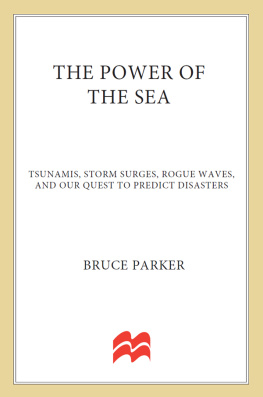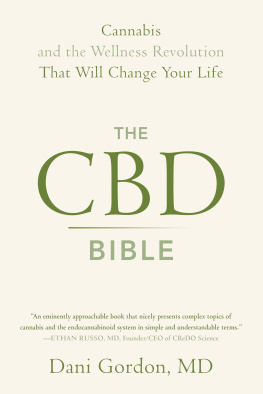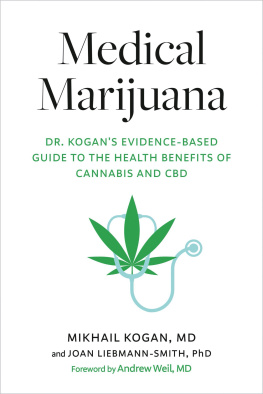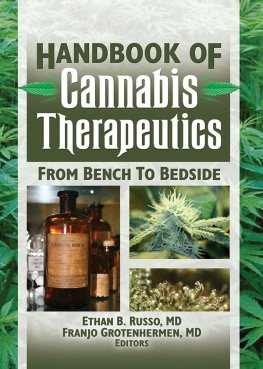Cannabinoids and the Brain
Linda A. Parker
The MIT Press
Cambridge, Massachusetts
London, England
2017 Massachusetts Institute of Technology
All rights reserved. No part of this book may be reproduced in any form by any electronic or mechanical means (including photocopying, recording, or information storage and retrieval) without permission in writing from the publisher.
Set in Sabon LT Std by Toppan Best-set Premedia Limited. Printed and bound in the United States of America.
Library of Congress Cataloging-in-Publication Data
Names: Parker, Linda (Linda A.), author.
Title: Cannabinoids and the brain / Linda Parker.
Description: Cambridge, MA : The MIT Press, [2017] | Includes bibliographical references and index.
Identifiers: LCCN 2016030736 | ISBN 9780262035798 (hardcover : alk. paper)
eISBN 9780262338431
Subjects: LCSH: Nervous system--Degeneration--Treatment. | Cannabis--Therapeutic use. | Marijuana--Therapeutic use.
Classification: LCC RM666.C266 P37 2017 | DDC 615.7/827--dc23 LC record available at https://lccn.loc.gov/2016030736
ePub Version 1.0
for Ernie
Preface
My keen interest in the endocannabinoid system began with an airmail envelope from Israel that arrived in my faculty mailbox in the year 2001. In late 1999, Cheryl Limebeer and I published a paper showing that THC reduced nausea in a rat model that we had had a role in developing. Shortly after the paper was published, I received a letter from Professor Raphael Mechoulam suggesting that we test non-psychotropic cannabidiol in that model. I was thrilled! The letter began a very exciting and fruitful collaboration that brought me into the exciting world of endocannabinoids. In 2002, at Professor Mechoulams kind invitation, I attended my first meeting of the International Cannabinoid Research Society, in Monterey, California, at which I met Professor Mechoulam and several other outstanding researchers who would later become collaborators.
In addition to Professor Mechoulam, our group has had the good fortune of collaborating with such leaders in their field as Roger Pertwee (University of Aberdeen), Keith Sharkey (University of Calgary), Daniele Piomelli (University of California at Irvine), Aron Lichtman (Virginia Commonwealth University), Benjamin Cravatt (Scripps Research Institute), Loren Parsons (Scripps Research Institute), Alexandros Makriyannis (Northeastern University), Paul Fletcher (Center for Addiction and Mental Health), Bryan Kolb (University of Lethbridge), Klaus-Peter Ossenkopp (University of Western Ontario), John Salamone (University of Connecticut), Ganesh Thames (Northeastern University), and Matias Lopez (University of Oviedo), and with my wonderful colleagues at the University of Guelph, Elena Choleris, Francesco Leri, Boyer Winters, Bettina Kalisch, and Craig Bailey. Over the past ten years these collaborations have provided outstanding training opportunities for members of my laboratory, including Cheryl Limebeer, Erin Rock, Martin Sticht, Kiri Wills, Lesley OBrien, Shadna Rana, Katherine Tuerke, and Gavin Petrie. It is these hard-working, enthusiastic, highly skilled people who keep the process of discovery going in the laboratory. Nothing would happen without them.
This book is an expansion and update of a review paper, which Raphael Mechoulam kindly invited me to co-author, that appeared in the Annual Review of Psychology (Mechoulam and Parker 2013). Our collaborations over the past 15 years have always taken my research to new vistas. Astute and careful editing by Paul Bethge at the MIT Press has made the book a much better read. I thank him for his contributions to the clarity of my prose.
I draw the readers attention to four outstanding edited volumes on cannabinoids and endocannabinoids that have been published in the past few years: Handbook of Cannabis, edited by R. G. Pertwee (Oxford University Press, 2014), Handbook of Experimental Pharmacology, volume 231: Endocannabinoids, edited by R. G. Pertwee (Springer, 2015), International Review of Neurobiology, volume 125: Endocannabinoids, edited by L. Parsons and M. Hill (Elsevier, 2015), and Cannabinoids, ed. V. Di Marzo (Wiley-Blackwell, 2014). For more information, see the Information for Health Care Professionals on the Health Canada website at http://www.hc-sc.gc.ca/dhp-mps/marihuana/med/infoprof-eng.php.
The National Institutes of Health recently prepared a videocast of a two-day conference (Marijuana and Cannabinoids: A Neuroscience Research Summit) held in March of 2016 and featuring presentations by some of the foremost NIH-funded researchers. I encourage readers of this book to find a free evening, open the link (http://videocast.nih.gov), and hear about the current state of the research in this exciting field. I also recommend The Scientist, a video documentary (produced by Fundacin CANNA and available on YouTube) that provides an glimpse into the scientific and personal life of Raphael Mechoulam, the father of the endocannabinoid system, a humble, brilliant, generous, and truly delightful human being. I have had the great fortune of being able to call Professor Mechoulam my friend.
An Introduction to Cannabis
The cannabis plant has been used for recreational and medicinal purposes for more than 4,000 years, but only recently has scientific investigation of its effects begun to be fruitful. In 1964, at the Hebrew University of Jerusalem, the chemists Yehiel Gaoni and Raphael Mechoulam discovered the principal psychoactive ingredient in cannabis, 9-tetrahydrocannabinol (often referred to as THC) (Gaoni and Mechoulam 1964a). This discovery finally provided the scientific community with the tools needed to investigate the properties of this plant. Although it was clear that the psychoactive effects of THC were produced by its action on the brain, exactly how that happened was not discovered until 20 years later, when Allyn Howletts group at the St. Louis University Medical School discovered the cannabinoid-1 (CB1) receptors (Devane et al. 1988; Howlett et al. 1986). The brain distribution of these newly discovered receptors was found to be consistent with the known pharmacological effects of THC. This discovery raised a question: Why would the brain have receptors for a material derived from a plant? Obviously, the brain must produce chemicals similar to THC. Shortly thereafter, Mechoulams group discovered anandamide (AEA) (Devane et al. 1992) and 2-arachidonyl glycerol (2-AG) (Mechoulam et al. 1995; Sugiura et al. 1995), which are called endocannabinoids because they act on the same receptors as THC. And a second cannabinoid receptor was discovered: CB2, found primarily in the immune system (Munro, Thomas, and Abu-Shaar 1993). The discovery of the site of action of THC has uncovered a new brain chemical system that is intimately involved in all aspects of brain functioning.
Since the aforementioned discoveries, a large number of investigators have provided considerable scientific knowledge about the metabolism, biochemistry, and pharmacology of THC, mostly in animal models. In a recent comprehensive review, Pacher and Kunos (2013) state that modulating endocannabinoid activity may have therapeutic potential in almost all diseases affecting humans, including obesity/metabolic syndrome, diabetes and diabetic complications, neurodegenerative, inflammatory, cardiovascular, liver, gastrointestinal, skin diseases, pain, psychiatric disorders, cachexia, cancer, chemotherapy induced nausea and vomiting, among others. This bold statement is based on considerable pre-clinical scientific evidence in each of these fields. This newly discovered system is of great importance and can explain many of the medicinal claims that have been made for medical marijuana. However, because of legal constraints, very little clinical work has been done in humans (Mechoulam et al. 2014).












